From Drum and Croaker 2010 Issue
Display, Husbandry and Breeding of Dwarf Cuttle, Sepia bandensis, at the California Academy of Sciences
Richard Ross, Aquatic Biologist, Steinhart Aquarium, California Academy of Sciences,
55 Music Concourse Drive, Golden Gate Park, San Francisco CA, 94118 USA
Cuttles seem to always be on the want list for public aquarium displays; however, the species generally available, Sepia officinalis and Sepia pharaonis, require large exhibits which can be a major commitment in both husbandry and cost. It can also be difficult to justify the commitment of show space and resources to such short-lived animals (the life span of most cuttles is typically between 1 and 2 years). However, the dwarf cuttle, Sepia bandensis, is a species that can be housed in a much smaller exhibit than its larger cousins making it an attractive first step into public cuttle displays. Sepia bandensis perform all the exciting and interesting behaviors that make cuttles popular, and can even mate and lay eggs while on display. Even better, S. bandensis are not prone to damaging themselves by jetting into the sides of aquaria. At the California Academy of Sciences, we have been displaying S. bandensis for almost a year, the animals have successfully bred on display and we are well into raising our second generation.
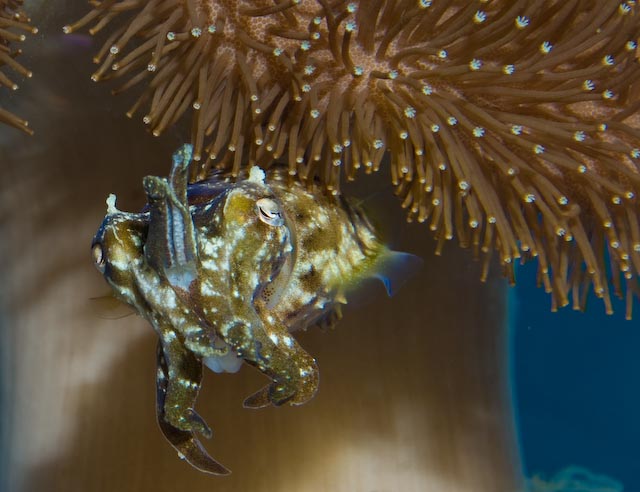
Procurement of animals, hatching of wild eggs, and housing of hatchlings
Sepia bandensis eggs are commonly available twice a year, around March and October, from marine wholesalers. In April 2009, the Aquarium received 3 egg clusters of approximately 20 eggs each, from Quality Marine in Los Angeles. The eggs were housed in a 5 gallon critter keeper sitting in a weir box of one of our back of house coral grow out systems. Water quality was coral compatible; temp 26C (78F), salinity 33-35 ppt, pH 8-8.4, calcium 380-400 ppm, alkalinity 7-9 dKH, ammonia 0, nitrate 0-10 ppm (NO3), PO4 0.05 ppm or below.
Water was supplied to the critter keeper by a Maxi Jet 1200 power head in the sump of the system, with the flow rate controlled by a ball valve. The water gravity drained through the slotted lid into the weir box. There was enough flow to gently keep the eggs ‘swaying’ and there were several cupfuls of fine sand on the bottom. By the end of April roughly 50 of the eggs had hatched and the hatchlings were kept as a group in the critter keeper. At this point the water flow was increased in order to keep any food items moving because cuttles hunt moving prey. Traditionally, it seems that hatchling cuttles have been kept in low flow environments, but it seems they do very well in higher flow captive environments as well. Since the hatchlings spend most of their time on the substrate, there was never had a problem with animals getting trapped against the lid as the water overflowed back into the system weir box.
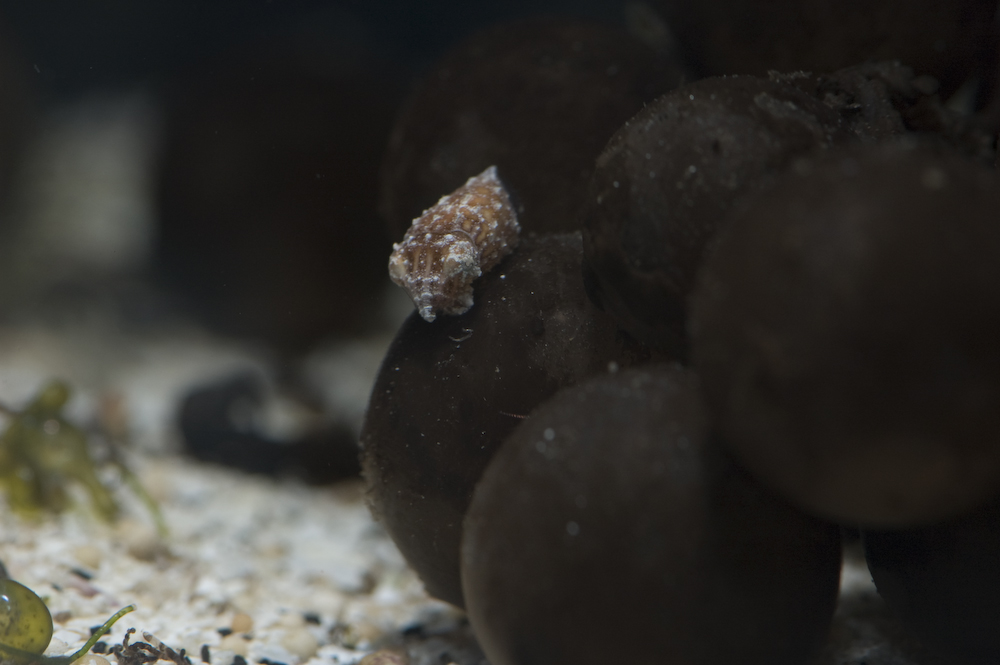
Feeding hatchlings
The biggest challenge raising S. bandensis from eggs is feeding the hatchlings. The challenge is twofold – appropriately sized food and getting enough of it. As the hatchlings grow, the size of the prey item offered needs to increase, and getting enough of any appropriate prey items can be costly. The Aquarium was able to supplement purchased food items with locally caught amphipods, locally caught freshwater mysids, and when the cuttles were larger, locally caught shore crabs of various species. It is also possible to wean juvenile cuttles onto thawed frozen foods, but this should be supplementary to live foods – more on this later.
Two quick notes on feeding hatchling S. bandensis: 1) Sometimes, hatchlings don’t appear to eat for the first week or so after hatching. It may be the case that they are actually not eating and may still be feeding on the remnants of their yolk sack; it may be that they are eating after lights out; or they may be eating small amphipods or copepods already present in the aquarium. In any event, they seem to come out of it and begin eating voraciously. 2) Enough people have anecdotally tried and failed to raise hatchling S. bandensis on enriched Artemia that I don’t think anyone need to try it again (although a study might be informative).
For the first few weeks after hatching, the hatchlings were fed twice a day with live mysids from Aquatic Biosystems and Aquatic Indictors. Mysid shrimp were gut loaded with newly hatched Artemia . Live mysids seem to be a perfect food because they are easily caught by the hatchling cuttles. After several weeks, amphipods were introduced into the diet. There seems to be a learning curve to the hunting ability of hatchling S. bandensis; amphipods are strong and when introduced too early in S. bandensis development, they are able to easily escape from the hungry cuttles possibly causing damage.
Around week 4, locally collected fresh water mysids were introduced into the diet, which the cuttles were able to catch and consume before the shock of being placed into saltwater stunned them into no longer moving.
Around week 6 we began to introduce thawed and rinsed frozen Piscine Energetics (PE) mysids into the diet. Initially, these were placed into the aquarium along with live mysids. Because of the decent flow rate, the cuttles would strike at the PE mysids as they was blown around in the water column. Within a week, one of the daily feedings became solely thawed PE mysids.
Around week 8, our hatchlings were between 1.2 cm (½ inch) and 2.5 cm (1 inch) in mantle length, and larger foods became necessary both from a nutritional and cost perspective. Fresh water ghost shrimp were available from a local wholesaler, however, keeping these alive long term became challenging. Marine ‘janitors’, Palamontes vulgaris, from http://livebrineshrimp.com/ were purchased and easily housed long term in a 20 gallon tank with an air driven sponge filter. These shrimp were approximately the same length as the cuttles and were readily consumed.
Feeding adolescents and adults
Once the S. bandensis were larger than 2.5 cm (1 inch long), saltwater grass shrimp, Cragnon spp. were purchased from a local bait shop and introduced into the diet. The Cragnon were kept in an auxiliary aquarium on a coldwater system kept at 11C (52F). Purchases of Cragnon include shrimp of different sizes, so it is easy to pick out the best size for the S. bandensis – even though at this size the cuttles can easily take prey larger than themselves. From time to time, they are also fed thawed silversides for variety, and have also been fed live saltwater mollies.
Feeding can be done by hand – the adults swim right to the surface at feeding and will eagerly take live or thawed frozen shrimp out of from your fingers, sometimes squirting you in the face with water from their funnels in the process. A feeding stick (a piece of rigid tubing with a 7.5 cm (3 inch) lengths of 80 pound test fishing line glued to it) can also be used to make sure that individual animals are getting food. For enrichment, the cuttlefish get appropriately sized live crabs or live shrimp introduced quietly into the tank to allow the cuttles to stumble upon them and hunt them at their leisure.
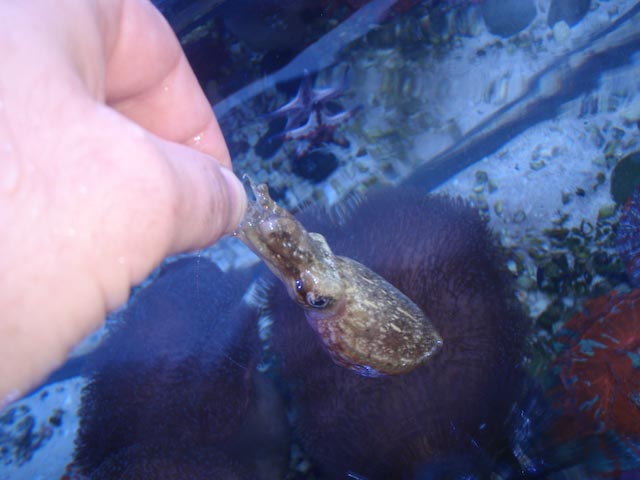
The display tank
When the hatchlings were around twelve weeks old they were ready to be put on display. A tank of approximately 450 L (120 gallons US) with dimensions of 122 cm x 61 cm x 61 cm (48”x24”x24”) that shared a common sump with three other tanks containing fish, inverts and corals was prepared for the cuttles by adding a mix of substrates, river rock, live rock, four large Sarcophyton sp., nine Acanthophyllia deshayesiana, and three Protoreastor sp. sea stars for clean up of uneaten cuttle food. Two 175 Watt MH pendants containing 20,000K bulbs were added to support the needs of the corals. A rigid airline tube bubbles air near the surface, and produces aesthetically pleasing glitter lines. The total system volume is approximately 1,165 L (300 gallons US). Filtration includes various filter socks on the tank returns, a small fluidized reactor containing granular ferric oxide media and activated carbon, and an ASM G4+ protein skimmer. A remote deep sand bed for natural nitrate reduction is planned for the near future. As a result, water quality is maintained near the parameters described above.
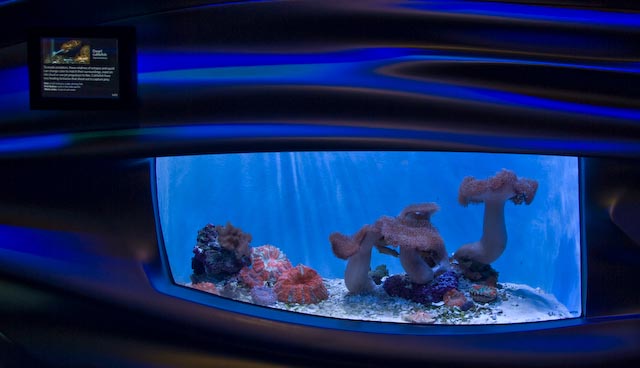
Initially, thirty juvenile S. bandensis, approximately 2.5 cm (1 inch) in mantle length, were introduced to the display. Since the animals were so small, and so good at camouflage, the idea was to saturate the exhibit with cuttles to make it easier for guests to see them. A graphic of a small cuttle on the substrate was also added to give the guests an idea of what to look for. The plan was to remove animals from the display as they got bigger and began to show sexual characteristics and possible aggression. It seems cuttles can tell the sex of other cuttles on sight, but aquarists can only tell the difference through dominance postures (which aren’t always accurate) or by directly observing mating.
Over the next several months, that strategy worked out well. The S. bandensis ate and grew and the males began to show themselves by facing of with each other, stretching and widening their bodies while darkening their patterns in a presumed effort to assert sexual dominance. There were a few losses, noticeable by the discovery of cuttlebones with beak bites missing from them: looking like a surfboard after a shark attack. It is unclear if the losses were due to natural aggression or cannibalism resulting from inadequate quantities of food or frequency of feedings.
As the animals matured, some were removed from the display to holding tanks behind the scenes, leaving a population of six S. bandensis on display: four females, one large male and one smaller male. Since the males are generally the aggressors in this species, the larger/smaller relationship was settled on in order to curtail dominance fighting.
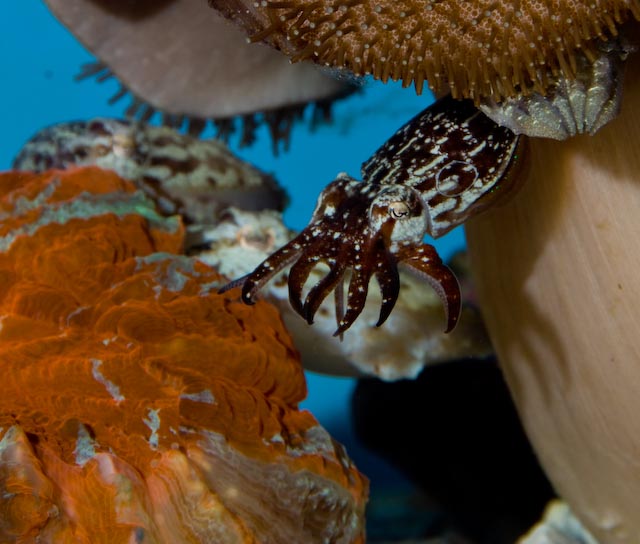
Mating
Like other cuttles, S. bandensis mate ‘fact to face’, intertwining arms for several minutes. Mating was observed in the animals on display at around sixteen weeks. Interestingly enough, while the larger male would be facing off with his reflection in the acrylic, the smaller male would be mating. As soon as the larger male noticed, the smaller male would stop, or be prevented from mating by the larger male.
Eggs
Even though mating had been witnessed for approximately four weeks, eggs weren’t discovered in the exhibit until the S. bandensis were about twenty weeks old. Eggs were laid one at a time, with a bit of ink incorporated into the ‘skin’ of the egg. Each egg took between two and five minutes to be laid and placed into the egg cluster, which is often attached to a rock in the exhibit. Clusters can be built up over several days and can range in size from a few eggs to 40 or 50 eggs. There does seem to be some post-laying parental interest in the eggs, with both the female and dominant male jetting water over the eggs from time to time for a few days after laying. It is unclear if clusters are laid by only one female at a time, or if several females can build clusters at the same time.
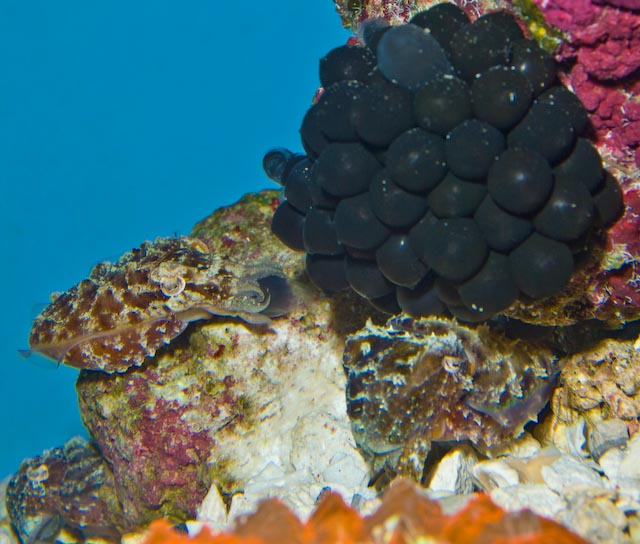
As the eggs developed and swelled they were moved off display and back into the critter keeper behind the scenes where we raised the parents. The eggs hatched in approximately one month.
Before working at the Steinhart Aquarium the author had bred S. bandensis several times in his home cephalopod breeding system. Although many eggs were laid the hatch rate was very low. In contrast, the amount of eggs laid at the Steinhart Aquarium was surprising, as was the number of eggs that hatched. Between August and November, approximately 600 eggs were laid on display, with the majority of them being viable. Over 300 eggs and hatchlings have been sent to other institutions. Egg laying didn’t end in December, but it did slow down noticeably. It will be interesting to see if fecundity drops off as the breeding group gets older. The author believes much of this breeding success is attributable to the amount of live food always available at the Steinhart Aquarium. The author’s home setup, didn’t allow for the housing of Cragnon spp., so there were frozen and fed out as needed. However, at the Aquarium frozen food was only kept as an emergency backup, and feed live food was fed twice a day instead. Further study is needed to determine the relationship between fresh and frozen food on fecundity of S. bandensis.
Preparing for the next group
With the success of the S. bandensis breeding on display, we replaced the critter keeper in back of house with a cube system plumbed into the same coral grow out system. There are now three cubes 30 cm x 25 cm x 25 cm (12”x10”x10”), fed by the same Maxijet 1200 power head, and gravity draining into the same sump that were used before. At the time of writing there are approximately thirty three-month-old cuttles, approximately eighty one-month-old cuttles along with several clutches of eggs both behind the scenes and on display. There are also several three-month-old S. bandensis that were purchased as eggs in September for genetic diversity when it appeared we would be successful with our breeding program.
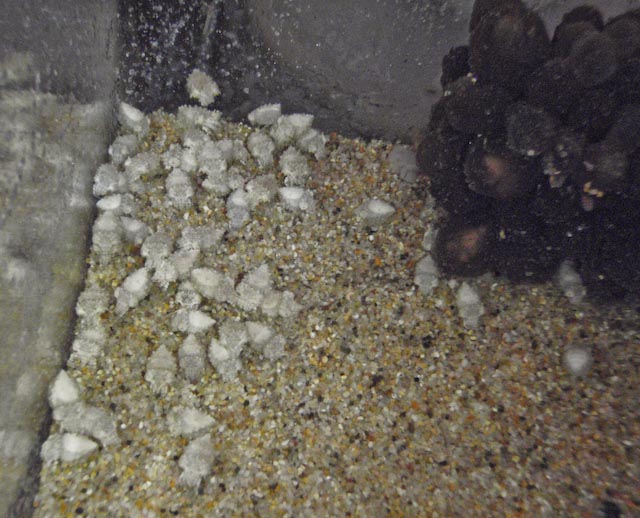
Final thoughts
The refined group of S. bandensis on display has been remarkably stable with very little fighting over time.
The amount of water flow in the display is fast enough for the Sarcophyton to visibly sway back and forth. S. bandensis don’t seem to care if the flow is fast or slow, and don’t seem to be working very hard to stay in position in the areas of higher flow.
The display of S. bandensis has been very successful from a husbandry standpoint and a guest experience standpoint – the cuttles are very popular with both docents and guests. Feeding time is especially popular!
We look forward to breeding more of these animals and sharing both display and breeding stock with other institutions.
Acknowledgements
The author would like to thank:
Matt Wandell, J. Charles Delbeek, Seth Wolters, Nancy Levine, April Devitt and Pam Montbach for helping to feed and care for these animals. Bart Shepherd for approving and supporting the display and breeding program of dwarf cuttlefish. J. Charles Delbeek, Bart Shepherd, Chris Andrews and Laura Kormos for their input on this article. Chris Maupin and Dr. James Wood for their help when beginning to keep and breed S. bandensis, and all of the members of www.TONMO.com for their help and support over the years.
References
Ross, R. “Sepia bandensis; Husbandry and breeding.” Tropical Fish Hobbyist, August 2009: (pp102-106)
Internet References
Ross, R. “Keeping and breeding the dwarf cuttlefish Sepia bandensis.” Advanced Aquarist, September 2005: http://www.advancedaquarist.com/2005/9/aafeature. Republished on TheCephalopodPage May 2007: http://thecephalopodpage.org/Sepiabandensis.php.